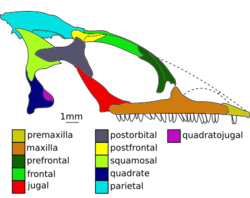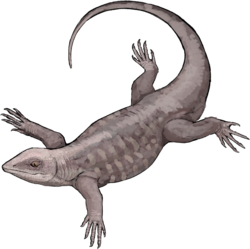Biology:Marmoretta
| Marmoretta | |
|---|---|

| |
| Skull of Marmoretta | |
| Scientific classification | |
| Domain: | Eukaryota |
| Kingdom: | Animalia |
| Phylum: | Chordata |
| Class: | Reptilia |
| Clade: | Lepidosauromorpha |
| Genus: | †Marmoretta Evans, 1991 |
| Type species | |
| †Marmoretta oxoniensis Evans, 1991
| |
Marmoretta is an extinct genus of small lepidosauromorph reptile known from the Middle Jurassic (Bathonian) of Britain, as well as the Late Jurassic of Portugal. It contains a single species, Marmoretta oxoniensis.[1][2]
Etymology
Marmoretta was first described and named by Susan E. Evans in 1991 and the type species is Marmoretta oxoniensis. The generic name is derived from Latin marmoros, meaning "Marble" and refers to the Forest Marble Formation - the source of the initial specimens of Marmoretta. The specific name is derived from Oxonia, the Latinised form of "Oxford", in reference to Oxfordshire.[1]
Discovery
Marmoretta is known from holotype BMNH R.12020, the anterior region of a right maxilla. Many specimens are referred to the species from the type locality, and together represent a nearly complete skull. All specimens are housed in the Natural History Museum. They were collected from the Mammal Bed of the Forest Marble Formation, at Kirtlington, Oxfordshire, which has yielded a rich assemblage of small vertebrates including mammals, frogs, salamanders and other small reptiles. Marmoretta is very common in that locality but its remains are fragmentary.[1] In 1994, additional specimens of Marmoretta were described from the Kilmaluag Formation (previously known as the Ostracod Limestones) of the Great Estuarine Group in Skye. This material of Marmoretta includes the first associated skull and postcranial remains. They confirm the original description and reconstruction, and provide additional support for position of Marmoretta as the sister taxon of Lepidosauria.[2] Both localities dates to the Late Bathonian stage of the Middle Jurassic period, about 166.2-164.7 million years ago.[1][2] In 2021, the Skye material was redescribed with CT scanning, and was found to slightly differ from the specimens from Oxford, with a different arrangement of palatal teeth and a differently shaped parabasisphenoid.[3] Remains have also been reported from the Alcobaça Formation in Portugal, dating to the Late Jurassic.[1]
Description
Marmoretta was a small reptile, with a maximum skull length of about 4 centimetres (1.6 in).[1] The dentiton is subpleurodont.[3]
Phylogeny
Susan E. Evans and Magdalena Borsuk−Białynicka (2009) performed a phylogenetic analysis that recovered Sophineta as the sister group of Lepidosauria. The inclusion of Sophineta displaced the relictual Middle Jurassic Marmoretta and gave the origin of Lepidosauria much older age. The cladogram below follows their results.[4] Some subsequent phylogenies have recovered Marmoretta as a stem-squamate, closer to squamates than to rhynchocephalians.[5][6] In the 2021 redescription, it was found to be a basal lepidosauromorph, most closely related to Fraxinisaura from the Middle Triassic of Germany.[3]
Cladogram after Griffiths, 2021:
| ||||||||||||||||||||||||||||||||||||||||||||||
References
- ↑ 1.0 1.1 1.2 1.3 1.4 1.5 Evans, S. E. (1991). "A new lizard-like reptile (Diapsida: Lepidosauromorpha) from the Middle Jurassic of England". Zoological Journal of the Linnean Society 103 (4): 391–412. doi:10.1111/j.1096-3642.1991.tb00910.x.
- ↑ 2.0 2.1 2.2 Waldman, M.; Evans, S. E. (1994). "Lepidosauromorph reptiles from the Middle Jurassic of Skye". Zoological Journal of the Linnean Society 112 (1–2): 135–150. doi:10.1111/j.1096-3642.1994.tb00315.x.
- ↑ 3.0 3.1 3.2 Griffiths, Elizabeth F.; Ford, David P.; Benson, Roger B.J.; Evans, Susan E. (September 2021). Ruta, Marcello. ed. "New information on the Jurassic lepidosauromorph Marmoretta oxoniensis" (in en). Papers in Palaeontology 7 (4): 2255–2278. doi:10.1002/spp2.1400. ISSN 2056-2799. https://onlinelibrary.wiley.com/doi/10.1002/spp2.1400.
- ↑ Susan E. Evans and Magdalena Borsuk−Białynicka (2009). "A small lepidosauromorph reptile from the Early Triassic of Poland". Paleontologica Polonica 65: 179–202. http://palaeontologia.pan.pl/PP65/PP65_179-202.pdf.
- ↑ Simões, Tiago R.; Caldwell, Michael W.; Tałanda, Mateusz; Bernardi, Massimo; Palci, Alessandro; Vernygora, Oksana; Bernardini, Federico; Mancini, Lucia et al. (May 2018). "The origin of squamates revealed by a Middle Triassic lizard from the Italian Alps" (in en). Nature 557 (7707): 706–709. doi:10.1038/s41586-018-0093-3. ISSN 0028-0836. PMID 29849156. Bibcode: 2018Natur.557..706S. http://www.nature.com/articles/s41586-018-0093-3.
- ↑ Sobral, Gabriela; Simões, Tiago R.; Schoch, Rainer R. (2020-02-20). "A tiny new Middle Triassic stem-lepidosauromorph from Germany: implications for the early evolution of lepidosauromorphs and the Vellberg fauna" (in en). Scientific Reports 10 (1): 2273. doi:10.1038/s41598-020-58883-x. ISSN 2045-2322. PMID 32080209. Bibcode: 2020NatSR..10.2273S.
Wikidata ☰ Q6772174 entry
 |


